A prison in Liverpool, an Ethereal Summit in New York city, a prestigious Russian art auction at Sotheby’s, a market in North Manchester. These places and the communities that spend time there have little in common. What is more, they sit at opposite ends of the spectrum of financial power. That’s exactly what appealed to Helen Knowles.
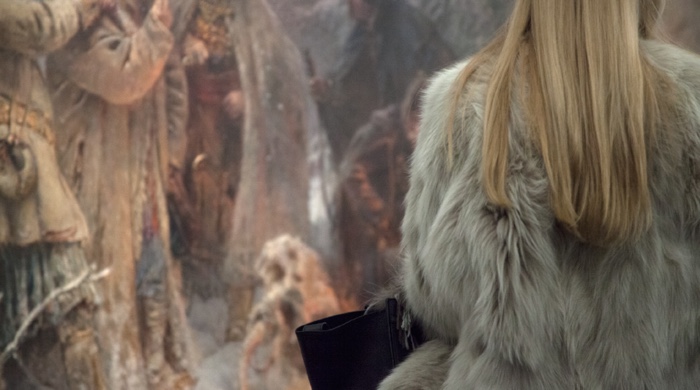
Helen Knowles, Trickle Down: A New Vertical Sovereignty (film still)
In each of these venues, the artist and curator documented (and in one case even staged) a series of auctions. She filmed the communities bidding on artworks, basic goods or house plants. Her images focus on the attire and attitudes rather than on the faces of these individuals. She even got some of them to sing, revealing the texture of the communities which represent such disparate socio-economic groups.
Helen Knowles is currently exhibiting the result of this long research at Arebyte Gallery in London.
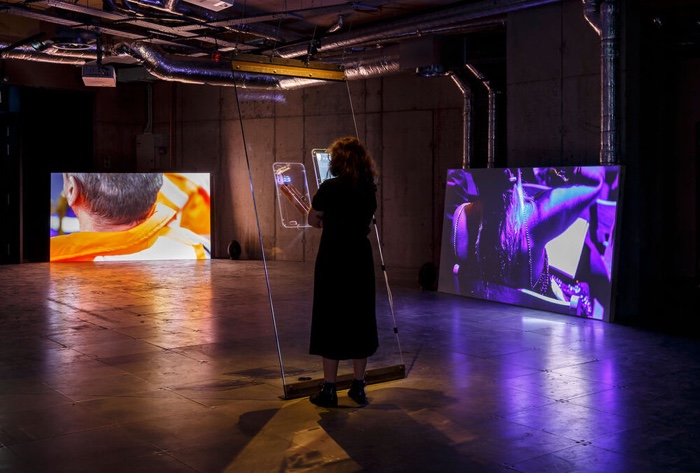
Helen Knowles, Trickle Down, A New Vertical Sovereignty. Installation at Arebyte Gallery in London. Photo by David Oates
At the center of the Trickle Down: A New Vertical Sovereignty installation is a machine that asks visitor to drop a £1 coin into a slot. The machine is transparent, allowing the public to witness the mechanisms needed to convert fiat currency into crypto-currency. Meanwhile, the movements of the visitors are picked up by sensors that detect the location and proximity of the audience to the screens in the room, this data changes the way the ambisonic soundscape is experienced in the room.
Each time the installation is activated, micro-payments are sent to the people who play(ed) a role -big or small- in the development and exhibition of the work: inmates at HMP Altcourse in Liverpool, blockchain software developers, art collectors, market sellers, etc. They all automatically receive a share of the ETH via a smart contract on the blockchain.
The artist helped the participant set up their own cryptocurrency wallet, prompting the question “can technology be a unifying force to enable more equality in society or does technology only work effectively for those who are educated to navigate it?“
Trickle Down, A New Vertical Sovereignty reveals some of the mechanisms of the blockchain as much as it challenges their promises and limits. Furthermore, the work raises questions about art funding, authorship, value systems, decentralised sharing economies, wealth distribution and other issues that are highly pertinent to society.
I talked to the artist right after the opening of the exhibition:
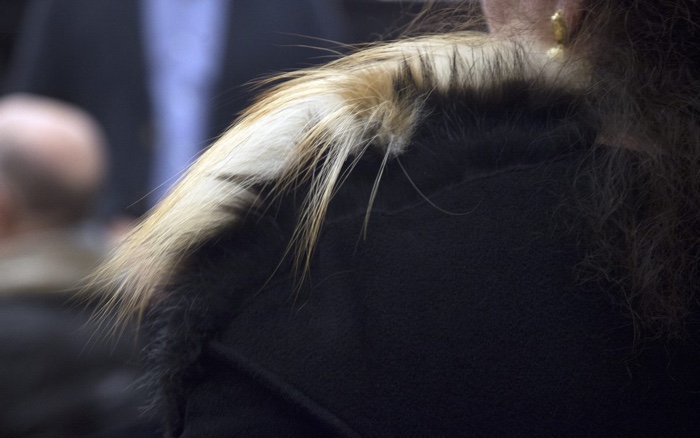
Helen Knowles, Trickle Down: A New Vertical Sovereignty (film still)
Hi Helen! Was it difficult to get the authorisation to film at the Sotheby’s auction?
I’ve been filming since 2014. At the beginning, I was mostly interested in exploring ideas around finance. I was then traveling between Manchester and London to do my MFA at Goldsmiths. Manchester and London are incredibly different places. London is a finance capital, with a lot of money being poured into it over the years. Whereas Manchester is a provincial British city. That was six years after the crash and there were lots of discussions about finance but in particular about the financial elites. There were also a lot of works that were pointing the camera at the wealthy. I was looking for a place where I could witness wealth so I went to Sotheby’s. I simply asked if I could photograph and they gave me a press pass to photograph at ‘The Important Russian Art Auction’ on the condition that I didn’t photograph anybody’s face. That’s how I started photographing the kind of clothes that the people were wearing which is interesting because clothes are huge signifiers of your status in society.
After that one auction, however, I was not allowed to take photos again. I had just one lucky break when I could enter with a camera but after that it was impossible.
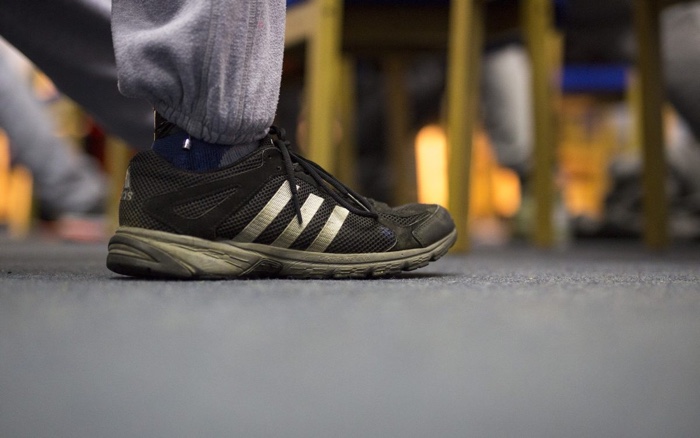
Helen Knowles, Trickle Down: A New Vertical Sovereignty (film still)
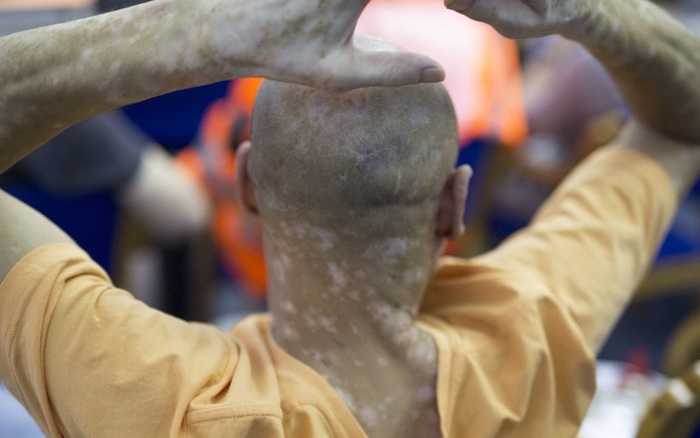
Helen Knowles, Trickle Down: A New Vertical Sovereignty (film still)
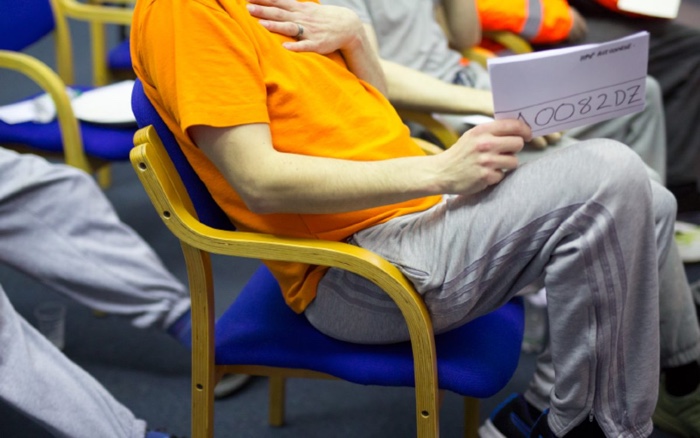
Helen Knowles, Trickle Down: A New Vertical Sovereignty (film still)
How about the prison? Is it tricky to enter a prison and speak to the inmates?
At the same time as I was going to Sotheby’s, I was also going to the Openshaw market in North Manchester which is at the opposite end of the wealth spectrum. People you meet there are migrant workers, refugees and other people buying goods at auction for 20p, 50p, etc. I started to do a residency with Future Everything it was through that organisation that I got asked to do a residency in a prison part of a programme by FACT which supports artists to go and do works in prisons.
At the beginning, I had no idea what I was going to do. I only knew that it would be interesting because obviously prisoners have no financial power in society and that prisons have their own ecosystems that have a different value system from the rest of us.
I went to the prison with Denis Jones, a musician I was working with at the time. We talked to the prisoners about their value system, what they prized, how they earned money, the sort of things they were able to buy, the black market taking place in prisons, etc. After a good few hours of conversations, we suddenly had this idea of staging an auction.
My previous artwork, The Trial of Superdebthunterbot, consisted in putting an algorithm on trial inside a court. I’m interested in working with people in the framework of their real life role. I got lawyers to defend and prosecute the algorithm for example.
I had shown the prisoners the auction scenes from London and Manchester. They then helped to stage the auction as a performance. When we asked what they would like to bid on, they sat there for a while, thought about the question and then said that what they really want was plants. They wanted to take care of them. On the one hand, you have the super rich bidding on the 1.4 million pound paintings. On the other, the poor bidding on knickknacks and then the prisoners wanting to simply express their humanity and love by being allowed to look after something.
The prison guards, however, told us that it wasn’t feasible, that plants would be a potential security risk but that prisoners could still bid on plants and send them to their families. So that’s what we did. The interesting thing was that they said they didn’t want to bid with money because they were upset about the ways you can earn money inside the prison. Instead, they wanted to bid with their time. Which meant that everybody who walked into the auction was equal, they had not already accumulated money in order to be able to bid, everyone would just have time to bid with.
I also got the prisoners to sing. I’m interested in the different communities and the textures of these communities. Getting them to sing was a way for them to express themselves but also to add another layer with their voices.
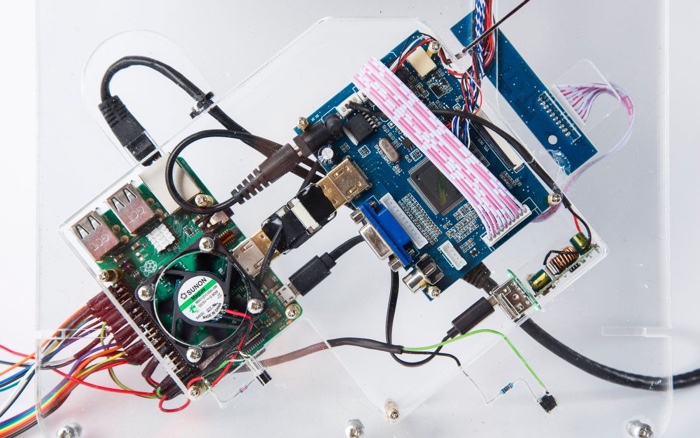
Helen Knowles, Trickle Down: A New Vertical Sovereignty (Detail of machine). Photo: David Oates
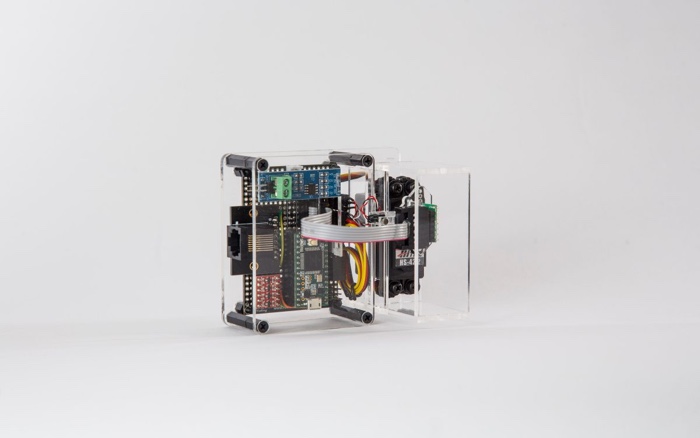
Helen Knowles, Trickle Down: A New Vertical Sovereignty (Detail of machine). Photo: David Oates
I’m curious about the machine you’re exhibiting at Arebyte. This machine exposes the mechanisms that convert fiat currency into crypto-currency. Alongside the machine, the film and soundscape triggered by sensors are responding to visitors to the installation. How does it work exactly? How are they connected to the blockchain and the redistribution of money?
We were in prison at the end of 2018-early 2019, that’s when the price of cryptocurrencies was going through the roof. Bitcoin was becoming ridiculously more valuable. I had been interested in Bitcoin for quite a long time. I didn’t really understand blockchain but I thought that at this point it would be interesting to go to the Ethereum summit in New York because they had made a call out to artists. The Ethereum Summit was a big conference organised by ConsenSys. I wanted to see if I could get the employees of ConsenSys to sing. It also happened that the Summit had the first ever digital art auction called The Codex Auction. I was able to record the auction and take photographs of people’s clothes. I also managed to convince some of the employees at ConsenSys to sing. We set up a recording studio at their offices. I was working with two musicians, Arone Dyer and Denis Jones. We just asked people if they’d join and sing with us. And they did!
What did they sing?
I showed prisoners videos about Benjamin Bratton’s theories, I talked about ideas about systems, etc. The prisoners drew from that and created a very simple line that was “Systems within systems within systems within systems. Borders within borders within borders within borders.” The Ethereum people didn’t sing specific lyrics, they just harmonised but the result was quite ethereal, almost like a Gregorian chant. Market sellers sang songs about money and I managed to get the ex wife of a Monoco heir to come to a recording studio and talk and sing about the kinds of people who attended the art auctions at Sotheby’s. Mainly by focussing on particular words in Russian.
Then I came up with the idea that you pay money in order to witness the piece. To make the machine, I worked with an artist called Daniel Dressel. I had worked with him previously when he made a transparent computer that I used as a prop in my previous film, The Trial of Superdebthunterbot. I was interested in exposing the infrastructure that supports the digital world. So when I was thinking about this machine, I was thinking of working with Daniel to create it so that all the electronics would be exposed whatever this machine did.
Through Future Everything, I then got to know a Manchester-based blockchain company called BlockRocket. They sell art on the internet using Ethereum smart contracts. At that point I started wondering whether it wouldn’t be interesting to reimburse the people involved in the piece while looking at ideas of value, altruism, labour, whether or not you are paid for your time and how much, etc. Everybody could potentially be paid for the time they had spent working on this piece. The prisoners, the ex-wife of a Monaco millionaire who sang for me, etc.
The way we decided to pay people happened through a workshop at the Whitworth Art Gallery in Manchester. They were the ones who put the money up to build the machine but also to hold a public programme through which we could hold these workshops to discuss what the machine looked like and have an open discussion about who should get paid.
I’m looking at this idea of the physical fiat currency which of course is a concept. Just like Bitcoin or Ethereum. They are all concepts and their value is driven by different things like social media, the work of the sovereign state and its trustedness within the world, etc. They are not that dissimilar and yet people have a hard time wrapping their heads around virtual currency.
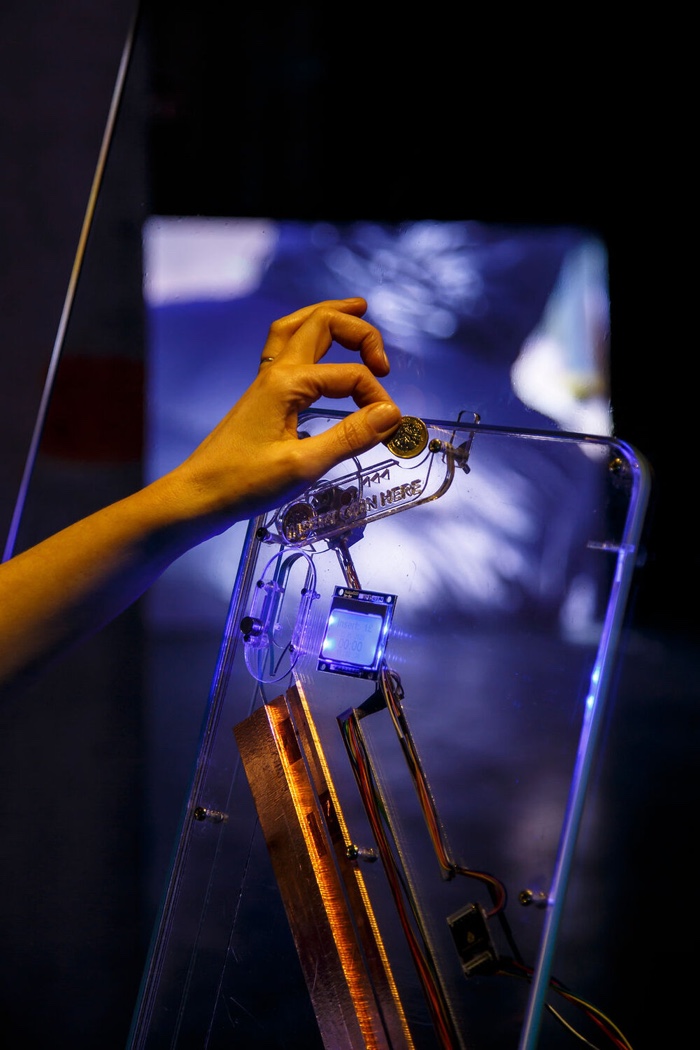
Helen Knowles, Trickle Down, A New Vertical Sovereignty. Installation at Arebyte Gallery in London. Photo by David Oates
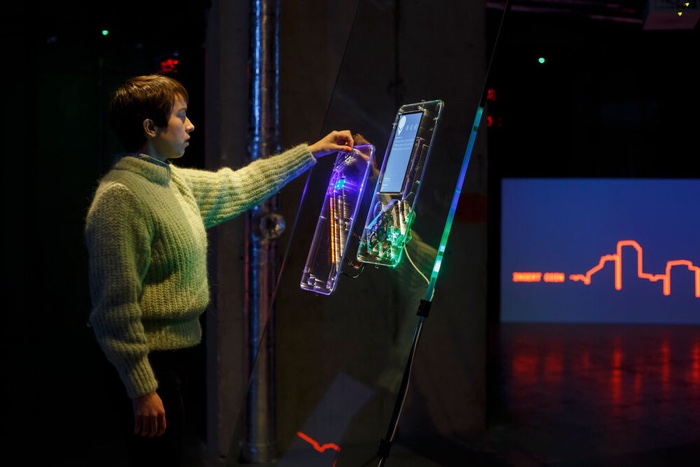
Helen Knowles, Trickle Down, A New Vertical Sovereignty. Installation at Arebyte Gallery in London. Photo by David Oates
Could you tell us about the soundscape?
The way you experience the piece is that you walk into the space and you are confronted by the sculpture which asks you to insert the coin. Once you’ve inserted the coin, you can watch it going through the machine. The machine then sends a signal that does two things: start the videos and trigger the smart contracts to make the payments. It thus splits one pound into the equivalent value of Ethereum between -at present- 28 people. That number will probably go up over the course of the piece touring because when we had this conversation about who should get paid, people decided that the future institutions should also get paid. Which is interesting because how you value a work is obviously not simply about its monetary value but also where it is shown, who writes about it, etc.
If you’re paying future venues, there’s a potential ethical dilemma but it mirrors this idea of incentivisation in the blockchain. I’m not sure whether or not this is ethically correct but it is interesting.
Once you’ve witnessed the four videos, you move into the soundscape. The videos are not moving images, they are still photographs with a soundtrack. They then go on repeat and the soundtrack starts. For the soundtrack, I worked with a composer called Pablo Galaz Salamanca. It is ambisonic. There are 8 speakers in the exhibition room and they make up 4 different sources which are connected to Sotheby’s, Openshaw, the prison and the Ethereum auctions. I recorded the different environments. The doors banging, the keys dangling and the sounds of the gym in the prison; the coins in the market as well as the vocal recordings. This is the meat of the composition. Data generated by the sensors positioned to record whether or the not the audience is close or away from a particular screen effects the sound diffusion and spatialisation of the sound within the space and your perception of the composition. It also changes the volume, reverbs and filters to make things sound distant. We aim to keep a record of the data history, like the ledger on the blockchain, which could be accessed in the future to replay a particular moment in time.
Helen Knowles, The Trial of Superdebthunterbot (trailer), 2016
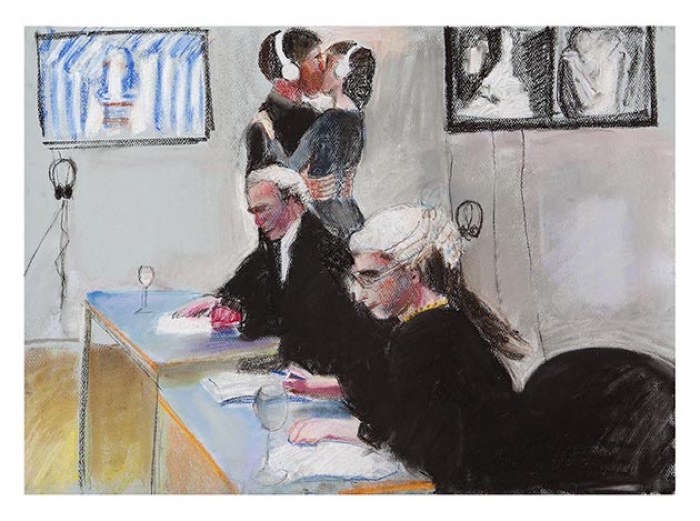
Helen Knowles, The Trial of Superdebthunterbot (One of the seven court drawings by Helen Knowles and Liza Brett), 2016

Helen Knowles, The Trial of Superdebthunterbot (film still), 2016
My last question regards your previous work, The Trial of Superdebthunterbot, a performance during which real lawyers debate on whether or not a fictitious (but uncannily credible) algorithm can be found guilty in case people die following one its “decisions”? The work toured around law schools. What were the reactions of students and lecturers in those schools?
Interestingly, I took it to about 4 or 5 law schools in 2015-2016. At the time, the issue wasn’t discussed as much as it is today. The lecturers told me that the law was just starting to try and catch up. One of the most interesting conversation I had about the piece took place at the Zabludowicz Collection in London. They showed the piece for 6 weeks and then staged a kind of reconstruction of the trial. We brought together a group of 12 experts in the field. And people had very different ideas about the issue. We had a couple of female coders who kept saying that an algorithm nothing more than a recipe. Other people with different expertise, perhaps more philosophical, did not see it like that. It showed how debatable the topic can be.
Thanks Helen!
Trickle Down: A New Vertical Sovereignty is at Arebyte Gallery until Wed 26 Feb, open Tuesday – Saturday 12-6pm.
